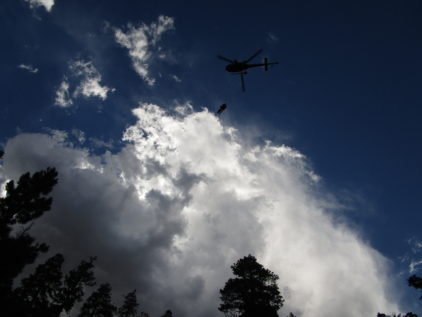On the morning of July 19, 2020, a group of four experienced hikers were leaving their campsite in upper Tuttle Creek to hike back to their cars, when a member of the group dislodged an unstable rock with his left foot. That same foot was then caught by a tree root and, unable to catch his fall in the steep terrain, the hiker fell and broke his lower leg.
The other members of the group were able to contact Inyo County SAR to ask for help. Based on the patient’s location, it was determined that the rescue should involve a helicopter if possible, since a carry-out in that kind of steep and sandy terrain would take very long and be quite risky for both patient and rescuers.
While waiting for the rescue, the patient’s group members, all of whom were either Wilderness First Responders or EMTs, splinted his leg with a sleeping pad and some other available things, moved him to a clearing and prepared him for the rescue.
A nearby Army helicopter tried to get to the patient, but it didn’t have capability to hoist or short haul and there was no landing zone.
Therefore, H-80 was called for assistance (CHP-helicopter from the Inland Air Division). It arrived in Lone Pine at about 4 p.m., met with a rescuer, loaded her into the helicopter and took off for Tuttle Creek.
The rescuer was lowered to the patient via hoist, where she packaged the patient into a hot seat (a special seat for hoisting people without harness) and transferred her to the helicopter above. H-80 then hoisted the Inyo SAR member and the patient was flown to Southern Inyo Hospital in Lone Pine.
Takeaway:
It is excellent to have knowledge in first aid, especially wilderness medicine. The other hikers were able to splint the leg to prevent further damage and to speed up the rescue process.
Also, always keep in mind that rescues are lengthy processes, since it can take a long time for a helicopter to become available and fly to our remote Inyo County. This group had warm clothes and plenty of extra food and water to wait over 6 hours for SAR to arrive.

